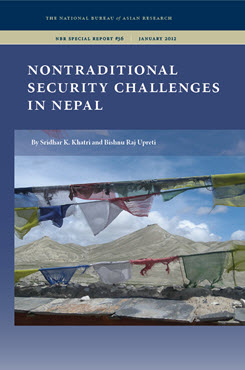Health and Human Security in Nepal and Possible Trajectories for 2025
This essay examines the current political canvas of Nepal, with a particular focus on health and human security issues, and explores possible scenarios for how the country might evolve through 2025.
EXECUTIVE SUMMARY
This essay examines the current political canvas of Nepal, with a particular focus on health and human security issues, and explores possible scenarios for how the country might evolve through 2025.
MAIN FINDINGS
- Economic and social uncertainty, introduced by political actors and interest groups jockeying for benefits during the current political transition period, reduces the human security of the general public, which the new constitution is supposed to ensure.
- Nepal continues to face major challenges in meeting minimum health standards and tackling the health disparities that exist among different population groups. Key health sector challenges faced by Nepal today include gender and ethnic/caste discrimination in provision of healthcare services, access to safe and adequate supplies of water, and basic access to health services.
- There are three possible scenarios for Nepal looking ahead to 2025, based largely on potential trajectories in the country’s level of governance: a “bleak” scenario, in which parties fail to effectively complete the constitution-making process; a “business-as-usual” scenario, in which parties are successful in drafting a constitution but are unable to implement it; and an “optimistic” scenario, whereby cooperation allows for more effective implementation of the constitution, leading to appreciable changes in the country’s human development indicators.
POLICY IMPLICATIONS
- The key element in ensuring proper healthcare within a human security framework is the quality of governance in the target country. The dominant threat to both human security and the integrity of state structures in South Asia is posed by internal conflicts.
- Nepal will need to focus on a steady human development approach with greater opportunities for the less-developed ecological regions and more balanced growth between the urban and rural areas. The government will also need to reach out to marginalized caste and ethnic groups, particularly the Dalits and Muslims, who rank lowest in the UN Human Development Index for the country.
- Four significant drivers will influence Nepal’s future trajectory: the behavior of the country’s political parties; the degree and nature of the international community’s involvement in Nepal’s affairs; the impact of technology on the country’s political, economic, and social development; and the perceptions and behavior of the Nepali people vis-à-vis the state.


